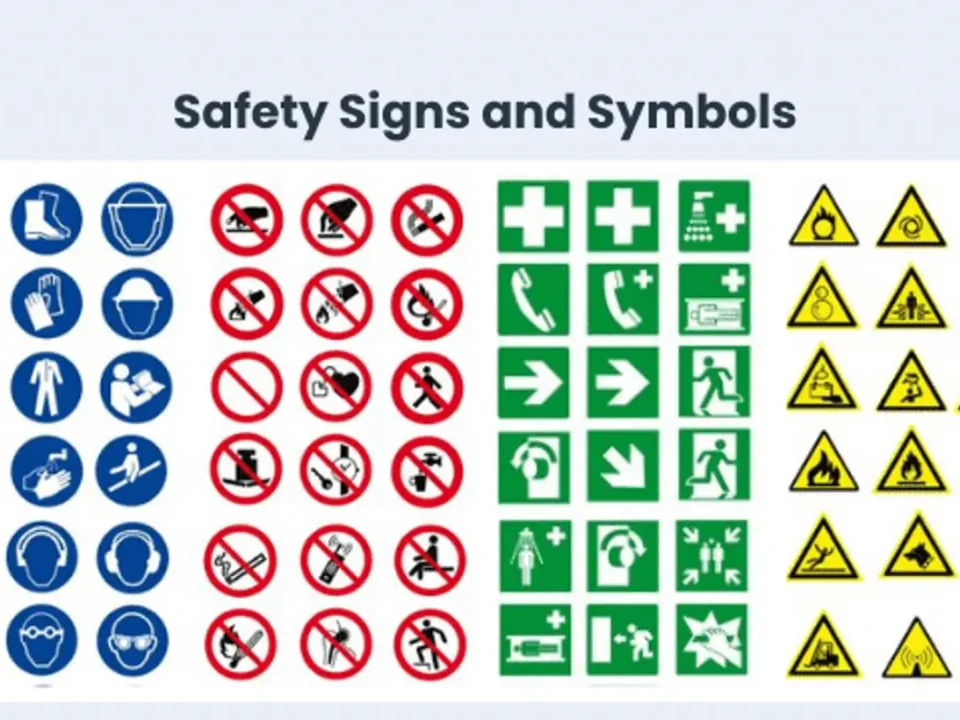Annual Safety Training Calendar List by TheSafetyMaster

What are Behavior-Based Safety Observations?
September 25, 2023
Training on First Aid by TheSafetyMaster
September 26, 2023Annual Safety Training Calendar List by TheSafetyMaster Blog Outline:
Introduction:
Welcome to TheSafetyMaster blog, where we take safety training to the next level. In this comprehensive guide, we will delve into the importance of annual safety training and how it can contribute to creating a successful and secure work environment. Prepare to be inspired as we share stories of organizations that have achieved safety excellence through diligent training efforts.
Why Safety Training Matters: Inspiring Stories of Success:
In this section, we will explore real-life accounts that showcase the transformative power of safety training. From dramatic reductions in workplace accidents and injuries to boosted employee morale and productivity, these stories will highlight the tangible outcomes that can be achieved through a commitment to regular safety training sessions. By sharing these tales of triumph, we aim to instill a sense of optimism and motivation for organizations seeking to prioritize their employees’ well-being.
Every organization, regardless of its size or industry, places great emphasis on the safety and well-being of its employees. Ensuring a safe working environment is not only a legal requirement but also a moral obligation that no organization can afford to neglect. However, with the constantly evolving nature of workplace hazards and regulations, it can be challenging for businesses to keep up with all the necessary training and compliance requirements.
In this comprehensive article, we will dive into the realm of annual safety training calendars. We will explore why safety training holds such significance in today’s world and how organizations can effectively plan and implement a robust training program. Whether you are an HR professional seeking guidance or a business owner striving for excellence in safety practices, this article promises to equip you with the knowledge and tools needed to create an impactful annual safety training calendar.
Why Safety Training Matters: Inspiring Stories of Success
Safety training is not just a legal and regulatory requirement; it is a crucial investment in the well-being of your workforce and the success of your organization. Countless stories of success highlight the transformative impact that effective safety training can have on individuals and companies alike.
Consider the case of ABC Manufacturing, a company that used to experience a high number of workplace accidents. Recognizing the need for change, they implemented a comprehensive safety training program. Through engaging and interactive sessions, employees were educated about hazard identification, proper equipment usage, and emergency response protocols. Over time, ABC Manufacturing witnessed a remarkable decline in accidents and injuries, resulting in increased productivity and cost savings.
Step 1: Assessing your Organization’s Safety Training Needs
Determining the safety training needs of your organization is a crucial first step toward fostering a culture of safety. Before developing a comprehensive annual training calendar, it is essential to conduct a thorough assessment that takes into account the unique requirements and risks associated with your workplace. This assessment should involve close collaboration between management, supervisors, and employees at all levels.
During the assessment phase, consider conducting employee surveys, analyzing incident reports, and reviewing industry regulations and best practices. Identify any patterns or trends in accidents or near-misses to pinpoint areas that require immediate attention. Engage with employees to gather their insights on potential hazards they encounter regularly and solicit their input on how training programs can be improved.
By conducting an in-depth assessment of your organization’s safety training needs, you will gain valuable insights into specific areas where additional focus is required. This process sets the foundation for effective training planning while ensuring that resources are allocated efficiently, thereby enabling your organization to proactively address potential risks and enhance overall workplace safety.
Step 2: Setting Clear Objectives for the Year Ahead
Setting clear objectives is a crucial step in ensuring the success of your annual safety training calendar. By clearly defining what you aim to achieve, you provide a roadmap for your organization to follow throughout the year. Start by conducting a comprehensive review of your previous safety performance, identifying areas that require improvement, and understanding any emerging risks or challenges.
Once you have identified the areas that need attention, it is time to set specific and measurable objectives. Consider incorporating both quantitative and qualitative goals, such as reducing the number of workplace accidents by a certain percentage or fostering a culture of safety where employees actively participate in maintaining a hazard-free environment. By aligning your objectives with your organization’s overall vision and values, you can create a sense of purpose and motivation among employees, fostering an optimistic atmosphere where everyone feels empowered to contribute to safety excellence.
Step 3: Designing Engaging and Interactive Training Sessions
When it comes to safety training, engaging and interactive sessions are key to capturing the attention and interest of your employees. By creating an atmosphere that fosters active participation, you can maximize the effectiveness of the training and ensure its long-lasting impact.
One way to design engaging training sessions is by incorporating real-life scenarios or case studies that resonate with your employees. These examples bring a sense of relevance and practicality to the training, allowing participants to connect theory with their own experiences. Additionally, utilizing multimedia elements such as videos, interactive quizzes, and simulations adds excitement and interactivity to the sessions.
Moreover, consider using group activities or role-playing exercises that encourage collaboration and problem-solving. This approach not only enhances teamwork skills but also helps individuals apply safety measures in a realistic setting. By fostering an environment where everyone actively participates, you create a sense of camaraderie while reinforcing key safety messages.
Remember, designing engaging and interactive training sessions requires creativity and innovation. Tailor your approach according to the nature of your organization’s work environment and employee demographics for maximum impact.
Step 4: Identifying the Most Effective Training Methods for Different Topics
In order to ensure impactful safety training, it is crucial to identify the most effective methods tailored to different topics. Safety training should not be a one-size-fits-all approach; instead, it should be carefully designed to address the specific needs of each topic and engage participants in a meaningful way.
When it comes to identifying the best training methods, consider incorporating a variety of techniques such as interactive workshops, hands-on simulations, case studies, videos, and storytelling. Each method has its own unique strengths and can be used strategically depending on the nature of the topic at hand.
For instance, interactive workshops allow participants to actively participate in discussions and problem-solving activities related to workplace safety challenges. This fosters collaboration and empowers individuals to develop practical solutions together. On the other hand, hands-on simulations provide an immersive experience that helps employees understand potential hazards and practice appropriate safety measures.
Case studies can be utilized for more complex safety topics by presenting real-life scenarios that encourage critical thinking and decision-making. Videos are an excellent tool for visually showcasing proper procedures or demonstrating potential risks in a compelling manner. Lastly, incorporating storytelling into training sessions adds a human touch and enables emotional connection with safety principles.
The key is to match the training method with the subject matter, ensuring that participants are actively engaged throughout the process. By employing diverse techniques specifically tailored to each topic, organizations can create a dynamic learning environment that promotes retention of information while cultivating a positive attitude towards safety.
Step 5: Scheduling and Organizing Training Sessions Throughout the Year
When it comes to creating an effective safety training calendar, careful planning and organization are paramount. By strategically scheduling training sessions throughout the year, you ensure that employees receive continuous education on critical safety topics, fostering a culture of awareness and preparedness within your organization.
Begin by reviewing your list of safety training topics from Step 1. Consider the frequency at which each topic should be covered based on its importance and relevance to your workplace. Some subjects may require monthly or quarterly sessions, while others can be addressed annually. Assign specific dates or timeframes for each training session, keeping in mind any industry-specific regulations or certifications that must be upheld.
Next, determine the duration and format for each training session. Consider whether certain topics would benefit from hands-on demonstrations or guest speakers. Break longer or more complex subjects into smaller modules that can be covered over multiple sessions for better retention. Make sure to incorporate interactive elements such as quizzes, group discussions, and practical exercises to keep participants engaged.
A well-organized safety training calendar ensures that vital information is disseminated consistently throughout the year. By thoughtfully structuring your sessions and incorporating engaging elements, you enable employees to learn effectively while fostering a positive attitude towards safety within the workplace.
Promoting Safety Culture Beyond Training
Creating a strong safety culture within an organization requires more than just training sessions. It involves fostering an environment where safety is ingrained in every aspect of day-to-day operations. By promoting safety beyond training, you can reinforce the importance of safe practices and encourage employees to take personal responsibility for their own well-being and that of their colleagues.
One effective way to promote safety culture is through regular communication and engagement. Encourage open dialogue about safety concerns, share success stories, and acknowledge employees who consistently demonstrate safe behaviors. Utilize various channels such as newsletters, bulletin boards, or even a dedicated section on the company intranet to keep safety at the forefront of everyone’s minds. Remember, positive reinforcement goes a long way in motivating individuals to adhere to safety protocols.
Step 7: Measuring Training Effectiveness and Making Improvements
Ensuring the effectiveness of your safety training program is crucial for the continuous improvement of your organization’s safety practices. It allows you to identify areas that require further attention and make necessary adjustments to enhance overall performance. To measure training effectiveness, consider implementing various evaluation methods that provide valuable insights into the impact of your training efforts.
One effective approach is conducting post-training assessments and surveys. These tools enable you to gauge participants’ knowledge retention, their perception of the training’s relevance, and their confidence in applying what they have learned. By analyzing these responses, you can identify any gaps in understanding or areas where additional reinforcement may be required.
Additionally, tracking safety performance metrics before and after training can provide tangible evidence of improvements resulting from your efforts. Comparing incident rates, near-miss reports, or other relevant indicators over time allows you to measure the direct impact of the training program on workplace safety outcomes. Remember that measuring effectiveness is not a one-time task but an ongoing process that informs continuous improvement.
Inspiring Case Studies: How Other Organizations Achieved Safety Excellence
Within the realm of safety training, real-life success stories serve as beacons of inspiration and motivation. By examining how other organizations have achieved safety excellence, we can learn valuable lessons and apply them to our own practices. Let’s explore a couple of remarkable case studies that demonstrate the power of effective safety training.
Case Study 1: XYZ Manufacturing Company
XYZ Manufacturing Company, a leader in the industrial sector, successfully transformed its workplace culture by prioritizing safety training. In their journey towards safety excellence, XYZ implemented comprehensive annual training calendars that covered a wide range of topics such as hazard identification, emergency response protocols, and equipment handling. They ensured that each training session was engaging and interactive, using immersive simulations and hands-on exercises to enhance learning outcomes.
This commitment to continuous improvement paid off significantly for XYZ Manufacturing Company. Not only did they witness a significant decrease in workplace accidents and injuries, but they also experienced increased employee morale and productivity. Today, XYZ serves as an industry benchmark for safety standards.
Expert Tips and Best Practices for Effective Safety Training
In order to ensure that safety training is effective and achieves its intended goals, it is essential to follow certain expert tips and best practices. By incorporating these strategies into your training programs, you can create a culture of safety within your organization that leaves employees feeling empowered and motivated.
One key tip is to make the training sessions interactive and engaging. Instead of simply lecturing employees on safety protocols, incorporate hands-on activities, role-playing scenarios, and group discussions. This approach encourages active participation, enhances learning retention, and fosters a sense of teamwork among employees.
Another important practice is to provide regular refreshers throughout the year. Safety training should not be a one-time event but rather an ongoing process. By scheduling periodic refresher sessions or incorporating safety reminders in daily communications, you reinforce the importance of safety in the minds of employees.
In addition, it is crucial to tailor the training methods to suit different topics. While some subjects may be better suited for classroom-style instruction, others may require practical demonstrations or online modules. By utilizing a variety of training methods that align with each topic’s unique requirements, you can optimize learning efficiency and maximize engagement levels.
Furthermore, involving employees in the development of safety protocols can significantly increase buy-in and compliance. By soliciting their input during trainings or forming safety committees that allow them to contribute ideas and suggestions, you foster a sense of ownership over workplace safety within your workforce.
Lastly, measuring the effectiveness of your training programs is paramount in driving continuous improvement. Implementing assessment tools such as quizzes or surveys allows you to gauge knowledge retention while soliciting feedback
Conclusion
In conclusion, implementing an annual safety training calendar is crucial for fostering a culture of safety within organizations. By following the outlined steps and incorporating best practices, companies can enhance their employees’ knowledge, skills, and awareness regarding workplace hazards and prevention measures. The inspiring case studies showcased throughout this article demonstrate the significant impact that effective safety training can have on reducing accidents and creating a positive work environment. As organizations prioritize safety through comprehensive training initiatives, they not only prioritize the well-being of their employees but also contribute to increased productivity and success in the long run. So let us embark on this journey towards a safer tomorrow, where every individual feels empowered to make safety their utmost priority in all aspects of life.




